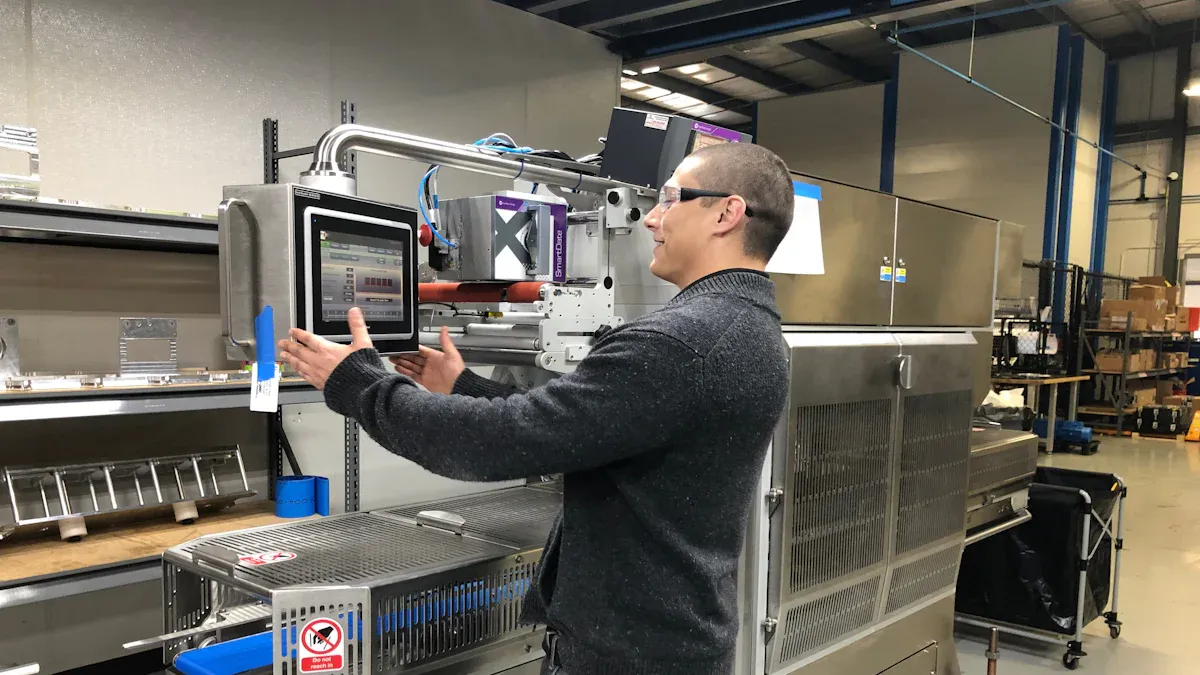
选择合适的食品生产线非常重要. 它会影响您工厂的运作情况和食品质量. 它还影响如何 环保的 你的过程是. 使用机器等趋势, 明确, 节省资源是关键. 您的生产线应符合您的业务目标和客户需求.
今天, 食品制造商必须遵守更严格的安全规则. 他们还需要使用简单的, 已知成分. 选择正确的生产线可以帮助您更好地工作并减少浪费. 它还可以帮助您明智地使用资源. 无论您是想节省时间还是遵守规则, 你的选择对你所做的一切都很重要.
要点
了解您的生产目标. 决定制作多少食物.
考虑您的产品需求. 不同的食物需要不同的工具.
谨慎花钱买机器. 比较成本与利润以获得更多收入.
使用自动化来加快工作速度. 机器有助于减少错误并提高安全性.
遵守食品安全规则. 这可以建立信任并确保您的工厂安全.
评估运营需求
定义生产目标和产能
了解您的生产目标是第一步. 决定您每天或每周想要制作多少食物. 这可以帮助您选择适合您需求的机器. 例如, 如果你需要做 10,000 一天的食物包, 选择适合该金额的设备.
高效生产食品意味着实现目标并保持高品质. 遵循如下规则 FSMA规则 204 帮助追踪食物并保存记录. 这减少了浪费并建立了与客户的信任. 更好的跟踪系统还可以改善供应商关系并使工作变得更轻松. 使用数字记录可以节省时间并减少文书工作.
证据 | 解释 |
|---|---|
FSMA规则 204 要求可追溯性和记录保存 | 合规性提高运营效率, 减少浪费, 并建立信任. |
增强的可追溯性提高了运营效率 | 减少浪费并加强供应商和客户关系. |
数字记录保存系统简化合规性 | 提高数据准确性并减轻管理负担. |
明确的目标有助于企业在不同行业取得成功. 例如:
建筑商尽早检查材料以满足项目需求.
绿色能源公司改进流程以获得更强大的产品.
医疗设备制造商标准化步骤以使客户满意.
满足产品特定要求
每种食品都需要 特殊设备. 考虑质感, 包装, 选择机器时的保质期. 例如, 冷冻食品需要能够应对低温并保持食物新鲜的工具. 面包机必须在正确的时间处理面团和烘烤.
客户的需求会影响所需机器的类型. 注重健康的买家想要有机或非转基因食品. 其他人则喜欢无麸质或即食餐. 自动化等新技术可帮助食品制造商满足这些需求. 例如, 面包店需要新口味或特殊饮食的机器.
特殊机器有助于为特定市场生产独特的食品.
自动化和智能技术使工厂更加灵活.
即食食品需要冷冻食品和快餐食品的机器.
注重健康的买家推动有机和非转基因食品工具.
面包店需要先进的机器来实现无麸质和定制口味.
预算和投资回报率考虑因素
购买食品生产设备需要仔细规划. 您需要检查购买成本, 设置, 和固定机. 预算有助于跟踪支出并找到划算的交易. 将成本与预期利润进行比较可以看出哪些选择最有利于投资回报率.
部分预算着眼于微小的变化, 就像购买新机器一样. 这确保每次购买都能帮助您的业务发展. 新的食品制作工具还可以省钱并有利于环境. 更好的管理可以减少浪费并降低成本. 智能灌溉系统节水并降低开支.
证据类型 | 描述 |
|---|---|
减少碳足迹 | 通过精确的投入管理减少温室气体排放, 降低一氧化二氮风险. |
循环农业 | 重新利用农业废物以降低成本并增强可持续性. |
投入成本降低 | 减少化肥和农药使用量 20-30% 通过精准应用. |
高效用水 | 先进的灌溉系统优化供水, 降低成本并解决稀缺问题. |
投资回报率 (投资回报率) | 精准管理和减少浪费带来更高的投资回报率. |
良好的预算和投资回报率规划可帮助您高效地生产食品并保持盈利.
评估自动化和技术
自动化在食品和饮料制造中的作用
自动化改变了食品和饮料的制作方式. 它使工作更快, 省钱, 并保证工人的安全. 机器可以完成重复的任务, 让员工专注于新想法并检查质量. 例如, 自动化设置需要更少的空间, 保存 25% 与旧系统相比. 他们还通过以下方式降低冷却成本 50% 具有更好的设计和存储.
自动化有助于确保工人的安全. 机器接管艰巨的工作, 减少伤害并提高工作速度. 叉车被自动化系统取代, 保护产品和建筑物免受损坏. 自动化还通过修复库存错误和减少拣货错误使订单更加准确.
提示: 使用自动化使您的工厂更安全、更高效.
为您的运营选择正确的技术
挑选 最适合您工厂的技术 需要仔细考虑. 人工智能等智能工具可以改变您的工作方式. 例如, 人工智能机器人发现缺陷 95% 准确性. AI包装机工作 40% 速度更快,材料浪费更少. 这些工具遵循安全规则并降低污染风险.
应用 | 影响描述 | 来源 |
|---|---|---|
基于人工智能的机器人检测 | 发现缺陷 95% 准确性 | 侯赛因等人. (2021) |
人工智能驱动的包装机器人 | 加快包装速度 40% 并且浪费更少的材料 | 李等人. (2023) |
无菌环境中的人工智能 | 降低污染风险并符合安全标准 | 刘等人。. (2023) |
人工智能在供应链优化中的应用 | 缩短交货时间 25% 并降低物流成本 15% | 伊万诺夫 & 多尔吉 (2021) |
人工智能在产品开发中的应用 | 使用数据帮助更快地创造更好的产品 | 沉等人. (2023) |
选择技术时考虑您的需求. 面包店可能需要无麸质或有机食品的机器. 冷冻食品制造商需要工具来保持食物冷藏和新鲜. 将技术与您的目标相匹配可帮助您高效地制作食品并让顾客满意.
确保系统集成和可扩展性
结合系统和增长规划对于成功很重要. 互联系统 让您实时观看您的工厂. 例如, 37% 食品工厂的 使用物联网传感器来阻止腐败和安全问题. 这些传感器提供即时更新, 帮助您快速解决问题.
可扩展的系统使增长更容易. 一家小型酱料公司使用 FlexiBake 在一年内将产量翻了一番, 特殊的 ERP 系统. 这个工具帮助他们省钱并更好地工作, 展示为什么可扩展的解决方案很重要.
机器人也帮助工厂发展. 用于包装和检查质量的自动化机器可以加快工作速度,让工人可以从事更艰巨的任务. 使用可扩展和互联的系统可以帮助您适应市场变化并保持竞争力.
笔记: 可扩展的系统可帮助您的业务发展并在食品制造领域保持领先地位.
确保质量和合规性
遵循行业规则和标准
食品制造商必须遵守严格的规则以确保食品安全. 这些规则保护人们并改善食品的制作方式. 例子包括 FDA 的食品安全现代化法案 (食品安全管理局) 和全球食品安全倡议 (GFSI). 这些规则可以阻止污染并提高生产质量.
食品行业经常制定自己的规则来解决健康问题. 例如, 针对儿童的广告导致更严格的规则. 这表明公众的担忧如何促使公司遵循更严格的指导方针.
证据类型 | 描述 |
|---|---|
食品行业自律 | 公司制定规则来处理健康问题. |
营销对健康的影响 | 儿童广告引发健康担忧, 导致新的规则. |
自律的历史 | 公众压力长期以来一直影响着行业行动. |
遵守这些规则有助于工厂更好地运作并建立客户信任.
为什么认证对质量很重要
认证很重要 确保食品安全和高质量. 它们有助于满足安全规则并改进食品的制作方式. HACCP 等系统检查风险并阻止问题. ISO标准还可以帮助工厂更好地工作并制造出好产品.
HACCP 检查风险 并确保食品安全.
ISO 标准改善了工厂的工作和产品制造方式.
FSMA 制定食品制造和运输新规则.
认证表明您遵循良好实践和严格规则. 它们降低风险并帮助您的工厂顺利运营.
建立强大的质量控制体系
良好的质量控制系统可确保食品安全和工厂高效. 这些系统发现风险并阻止污染. 例如, 食品安全管理体系 (FSMS) 改进培训和危机计划. 他们还跟踪重要的工厂目标.
案例研究描述 | 主要发现 |
|---|---|
中小型企业的 FSMS | 更好的培训和危机计划 (p < 0.001). |
胶囊制造工厂中的 HACCP | 通过 ISO 提高安全性 22000:2018 和 HACCP 规则. |
圣保罗乳品厂 | 新系统后酵母菌和霉菌减少 (p < 0.05). |
持续改进计划 使质量控制更加完善. 他们发现风险, 遵守严格的规则, 并削减食品安全问题的成本. 这些程序 保护客户 并省钱.
强大的系统保证食品安全和高质量. 他们保护客户并提高工厂的声誉.
培训和劳动力考虑因素
让员工为先进系统做好准备
现代机器需要熟练工人才能良好运行. 员工必须学会如何使用 自动化的 工具和 人工智能 系统. 培训可帮助工人了解这些工具并保持工作场所清洁. 例如, 接受过团队合作培训的工人 人工智能 可以处理新技术并使食品生产更加灵活.
良好的培训也支持环保生产. 了解创新的工人可以减少浪费并提高清洁度. 这建立了强大的系统,可以处理供应链问题并保持生产顺利.
提示: 提供完整的培训计划,帮助您的团队学习高级工具并遵守安全规则.
坚持培训,更好地工作
定期培训让员工了解新工具和方法. 进修课程提高食品安全知识和技能. 研究表明持续培训可以提高知识 45 时间和做法 14 次. 这有助于您的团队在食品生产中保持高标准.
使用精益制造方法使工作更加高效. 这些方法侧重于 减少浪费并改善供应链. 价值流图和即时生产等工具可以修复延迟并改进工作流程.
金属探测器和视觉工具 让食品更安全.
组合系统更容易学习并节省空间.
定期保养 停止故障并增加利润.
经常培训,工人熟练,生产线平稳运行.
将自动化与人工检查相结合
自动化 使食品生产更快、更准确. 但质量检查和棘手情况仍然需要人类. 混合系统将机器与人力投入相结合,以提高生产力并确保安全.
例如, 人工智能 可以在检查过程中发现问题, 但人们必须确认和分析数据. 在污染情况下, 机器动作快, 但人类确保采取正确的步骤.
方面 | 自动化做什么 | 人类做什么 |
|---|---|---|
效率 | 加快工作速度并减少错误 | 添加专家判断和决策 |
数据解读 | 发现问题但需要人工审核 | 确认并解释结果 |
处理复杂问题 | 解决不清楚或道德问题 | |
品质保证 | 提高速度和准确性 | 做出最终检查和决定 |
平衡 自动化 通过人力投入保持粮食生产创新, 安全的, 和高品质.
长期效率和可持续性
使用节能设备
节能工具对于改善粮食生产非常重要. 食品工厂使用 超过两倍的能量 其他企业的. 旧系统浪费高达 80% 能量的. 改用节能机器可降低成本, 改善工作, 并减少污染. 这些升级可帮助您省钱并保护地球.
益处 | 影响百分比 |
|---|---|
降低成本 | |
更高的利润 | 30% 和 20% 更高的效率 |
节能机器 也能更好地工作. 他们的食物烹饪得很好并且需要更少的维修. 这使您的工厂运行平稳且持续时间更长. 选择这些工具可以节省金钱并通过减少有害气体来保护环境.
提示: 节能机器帮助您省钱并保护自然.
减少食品生产中的浪费
减少浪费可以保持工厂清洁并改善其工作方式. 减少浪费可以拯救世界 $120-$300 十亿 每年由 2030. 这些节省对家庭和企业都有帮助.
您可以通过改进流程和使用智能机器来减少浪费. 例如, 分选机将好材料与垃圾分开. 这可以减少浪费并保持工厂清洁. 这些想法可以节省资金并提高生产质量.
关注减少浪费有助于地球并增加利润. 更好的流程可降低成本并有助于实现环保目标.
为未来的变更和升级做好准备
提前规划可以让您的工厂为未来的需求做好准备. 某大型食品公司 改进工作 20% 和工人的幸福感 25% 有升级. 他们的工厂现在可以处理更多的工作,同时保持高质量.
规划还有助于应对气候变化等挑战. 例如, 尼加拉瓜的咖啡制造商改变了方法来应对新的天气模式. 这说明了为什么规划对于粮食生产至关重要.
使用灵活的机器进行升级可帮助您的工厂随着需求的增长而发展. 这些设计让您无需停止工作即可添加新工具. 保持适应能力可以让您的业务保持强劲并为未来做好准备.
笔记: 规划升级可让您的工厂保持高效并为变革做好准备.
将您的食品生产线与您的目标相匹配有助于其顺利运行. 也让顾客满意. 良好的一致性可以产生新的想法, 灵活性, 和环保实践. 例如, 产品制造方式会影响效率, 产品设计让顾客更满意. 社会行动改善业务成果, 但处理退货可能会很棘手.
自动化, 安全检查, 和节约能源对于成功很重要. 机器使工作更快、更准确. 质量检查确保食品安全. 使用节能工具可以降低成本并帮助地球. 专注于这些事情可以让您的业务在不断变化的食品行业中保持强劲.
方面 | 与SOP匹配 | 对 SPM 的影响 |
|---|---|---|
高的 | 提高环保性能 | |
社会行动 | 中等的 | 帮助整体业务成功 |
产品设计 | 高的 | 提高效率和客户满意度 |
生产 | 高的 | 鼓励新想法和灵活性 |
退货处理 | 低的 | 显示匹配目标方面的问题 |
提示: 努力提高效率并遵守规则,以保持粮食生产的竞争力.
常问问题
选择食品生产线最重要的因素是什么?
专注于将生产线与您的业务目标相匹配. 考虑一下您需要制作多少食物以及产品类型. 遵守安全规则也有助于保持工厂平稳运行.
自动化如何提高食品产量?
自动化使工作更快、更安全. 机器做简单的任务, 以便工人可以检查质量并尝试新想法. 例如, 自动化工具使用更少的能源并更准确地包装食品.
提示: 选择 自动化工具 可以与您的工厂一起成长.
为什么遵守食品安全法规至关重要?
安全规则确保食品安全和高质量. 他们保护客户并帮助您的工厂避免问题. 遵循 FSMA 或 GFSI 等规则可以建立信任并使您的业务保持良好运营.
如何使我的生产线更具可持续性?
使用节能和减少浪费的机器. 智能工具可以对材料进行分类以减少垃圾. 规划升级可帮助您的工厂保持环保并降低污染.
笔记: 环保可以节省资金并提高您的品牌形象.
我是否需要对我的员工进行高级系统培训?
是的, 培训帮助工人更好地使用现代机器. 学习关于 自动化 和 人工智能 保持生产顺利. 定期课程确保工人了解最新的工具和方法.
提示: 提供实践培训,帮助工人感到自信和熟练.

如果你想探索 Instagram, 真正的 Instagram 点赞真的很重要. 我从 ankasosyal.com 购买, 我推荐.
珠宝机械的备件和维护服务确实快速且经济。.
很棒的东西. 对我帮助很大——请继续分享! 并检查我的网站: https://b1top0010.xyz/ !
这真的很有趣, 你是一位非常熟练的博主. 我已经加入了您的动态,并期待寻找您更多精彩的帖子. 还, 我已在我的社交网络中分享了您的网站!
大家好, 因为我真的很想阅读该网站定期更新的帖子. 它承载着令人愉快的东西.
Silivri漏水检测 法提赫公寓发生漏水. 团队检测非常专业. 我很满意. https://99info.wiki/?p=37534
我衷心感谢该网站的创建者分享如此精彩的文章. 很少遇到经过如此深入研究并以易于理解的方式呈现的内容. 我衷心感谢您的努力.
感谢您分享这篇博文. 再次感谢. 凉爽的.
非常有洞察力并且写得很好. 我从中学到了很多! 请检查我的网站: https://emopat.xyz/ !
Mehmet Akif 漏水检测是 Zeytinburnu 的一个非常好的漏水检测团队。. 他们立即解决了我们的问题. http://wakeof.net/author/kacak/
我是博客新手,非常欣赏您的内容. 这篇文章引起了我的兴趣. 为您的网站添加书签!
漏水检测法提赫漏水检测: 我们为您在法提赫的漏水问题提供明确的解决方案. http://blakemountford.com/author/kacak/
Kayışdağı 快速漏水检测, 干净、专业的服务. 推荐! https://www.vevioz.com/read-blog/40560
很棒的文章, 感谢您分享这些见解! 我测试了很多构建反向链接的方法, 真正对我有用的是使用人工智能驱动的自动化. 与我们一起, 我们可以以安全有效的方式扩展链接建设. 与手动外展相比,这节省了多少时间,真是令人惊讶.
**心灵库**
Mind Vault 是专为成人打造的优质认知支持配方 45+. 它经过精心设计,有助于保持清晰的思维
**心灵库**
Mind Vault 是专为成人打造的优质认知支持配方 45+. 它经过精心设计,有助于保持清晰的思维
**心灵库**
心灵库 是专为成人设计的优质认知支持配方 45+. 它经过精心设计,有助于保持清晰的思维
**呼吸**
呼吸 是一种植物酊剂,旨在促进肺功能并提高呼吸质量.
**呼吸**
呼吸 是一种植物酊剂,旨在促进肺功能并提高呼吸质量.
这是一篇很棒的文章, 我只是一个有趣的人, 继续做好工作, 刚刚读完 https://websiteerstellenlassenbamberg.de// 他们的工作非常棒. 如果您下次更新或发布,我将再次检查您的内容. 谢谢
Luong Son TV适合像我一样经常用手机看足球的人, 因为界面紧凑且易于点击. 户外使用4G观看依然流畅, 更少的滞后. 我经常关注英超联赛,因此网站上的比赛时间表可以帮助我更加主动. 总体而言,与许多其他平台相比,体验相当完整.
我的朋友介绍我所以我尝试了LuongSonTV并且很满意. 令人惊奇的是,比赛安排得很清楚,很容易上手. 视频质量比许多网站之前看到的要好. 对于像我这样的新手来说,这是一个可靠的选择.
你的博客是我源源不断的灵感来源. 您对主题的热情是显而易见的, 很明显,你在每一篇文章中都倾注了心血. 继续进行令人难以置信的工作!
你的博客是我源源不断的灵感来源. 您对主题的热情是显而易见的, 很明显,你在每一篇文章中都倾注了心血. 继续进行令人难以置信的工作!
一篇文章包含如此多的价值!
您可以更具体地对文章的内容更具体吗? 阅读后, 我仍然有疑问. 希望你能帮我.
感谢您的分享. 我读了您的许多博客文章, 凉爽的, 您的博客很好.
Tham gia QQ88 để khám phá casino live, thể thao, slot nổ hũ, bắn cá đổi thưởng cùng hàng loạt khuyến mãi độc quyền mỗi ngày.